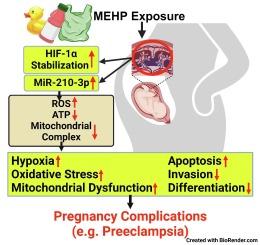Mono-(2-ethylhexyl) phthalate induces trophoblast hypoxia and mitochondrial dysfunction through HIF-1α-miR-210-3p axis in HTR-8/SVneo cell line
Abstract
The exposure to the ubiquitous phthalate metabolite mono-(2-ethylhexyl) phthalate (MEHP) is connected to dysregulated trophoblast function and placenta health; however, the underlying mechanisms preluding this scenario remain to be elucidated. In this study, we explored the hypoxemic effects of MEHP on a human placental first-trimester trophoblast cell line (HTR-8/Svneo). MEHP-treated trophoblast cells displayed significantly increased levels of oxidative stress and hypoxia-inducible factor-1 alpha (HIF-1α) attributed by the induction of hypoxia. Further, HIF-1α exhibited higher DNA binding activity and upregulated gene expression of its downstream target vascular endothelial growth factor A (VEGFA). The hypoxia-induced microRNA miR-210-3p was also significantly increased upon MEHP treatment followed by disrupted mitochondrial ATP generation and membrane potential. This was identified to possibly be facilitated by lowered mitochondrial DNA copy number and inhibited expression of electron transport chain subunits, such as mitochondrial complex-IV. These results suggest potential adverse effects of MEHP exposure in a trophoblast cell line mediated by HIF-1α and the epigenetic modulator miR-210-3p. Chronic placental hypoxia and oxidative stress have long been implicated in the pathogenesis of pregnancy complications such as preeclampsia. As we’ve revealed genetic and epigenetic factors underscoring a potential mechanism induced by MEHP, this brings to light another significant implication of phthalate exposure on maternal and fetal health.


 求助内容:
求助内容: 应助结果提醒方式:
应助结果提醒方式:


